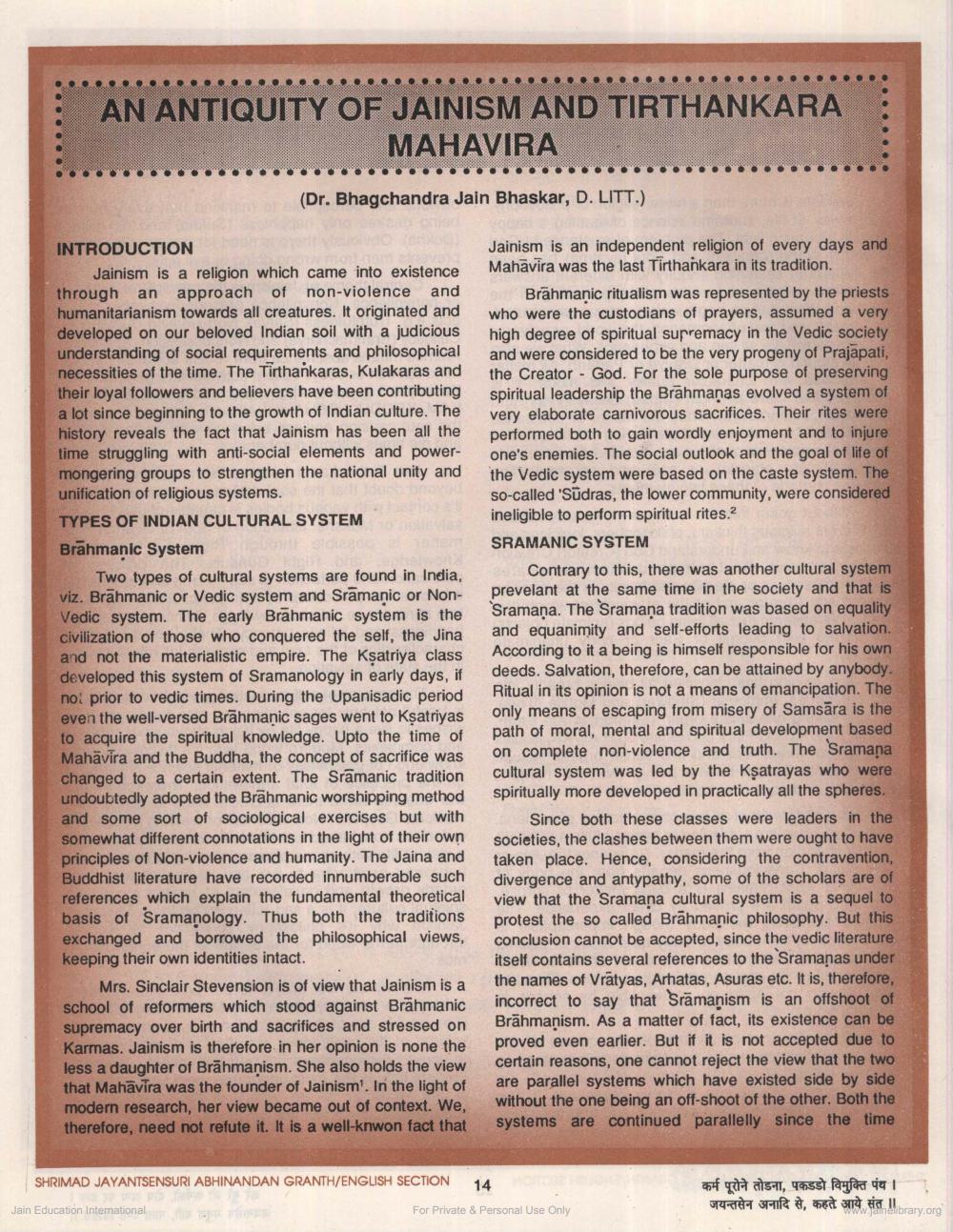Book Title: Antiquity or Jainism and tirthankara mahavir Author(s): Bhagchandra Jain Publisher: Z_Jayantsensuri_Abhinandan_Granth_012046.pdf View full book textPage 1
________________ AN ANTIQUITY OF JAINISM AND TIRTHANKARA MAHAVIRA (Dr. Bhagchandra Jain Bhaskar, D. LITT.) INTRODUCTION Jainism is a religion which came into existence through an approach of non-violence and humanitarianism towards all creatures. It originated and developed on our beloved Indian soil with a judicious understanding of social requirements and philosophical necessities of the time. The Tirthankaras, Kulakaras and their loyal followers and believers have been contributing a lot since beginning to the growth of Indian culture. The history reveals the fact that Jainism has been all the time struggling with anti-social elements and powermongering groups to strengthen the national unity and unification of religious systems. TYPES OF INDIAN CULTURAL SYSTEM Brāhmanic System Two types of cultural systems are found in India, viz. Brahmanic or Vedic system and Sramanic or NonVedic system. The early Brahmanic system is the civilization of those who conquered the self, the Jina and not the materialistic empire. The Kșatriya class developed this system of Sramanology in early days, if no: prior to vedic times. During the Upanisadic period even the well-versed Brāhmanic sages went to Ksatriyas to acquire the spiritual knowledge. Upto the time of Mahävira and the Buddha, the concept of sacrifice was changed to a certain extent. The Sramanic tradition undoubtedly adopted the Brāhmanic worshipping method and some sort of sociological exercises but with somewhat different connotations in the light of their own principles of Non-violence and humanity. The Jaina and Buddhist literature have recorded innumberable such references which explain the fundamental theoretical basis of Sramanology. Thus both the traditions exchanged and borrowed the philosophical views, keeping their own identities intact. Mrs. Sinclair Stevension is of view that Jainism is a school of reformers which stood against Brahmanic supremacy over birth and sacrifices and stressed on Karmas. Jainism is therefore in her opinion is none the less a daughter of Brahmanism. She also holds the view that Mahavira was the founder of Jainisml. In the light of modern research, her view became out of context. We, therefore, need not refute it. It is a well-knwon fact that Jainism is an independent religion of every days and Mahavira was the last Tirthankara in its tradition. Brāhmanic ritualism was represented by the priests who were the custodians of prayers, assumed a very high degree of spiritual supremacy in the Vedic society and were considered to be the very progeny of Prajapati, the Creator - God. For the sole purpose of preserving spiritual leadership the Brahmanas evolved a system of very elaborate carnivorous sacrifices. Their rites were performed both to gain wordly enjoyment and to injure one's enemies. The social outlook and the goal of life of the Vedic system were based on the caste system. The so-called 'Sudras, the lower community, were considered ineligible to perform spiritual rites.2 SRAMANIC SYSTEM Contrary to this, there was another cultural system prevelant at the same time in the society and that is Sramana. The Sramana tradition was based on equality and equanimity and self-efforts leading to salvation. According to it a being is himself responsible for his own deeds. Salvation, therefore, can be attained by anybody. Ritual in its opinion is not a means of emancipation. The only means of escaping from misery of Samsāra is the path of moral, mental and spiritual development based on complete non-violence and truth. The Sramana cultural system was led by the Ksatrayas who were spiritually more developed in practically all the spheres. Since both these classes were leaders in the societies, the clashes between them were ought to have taken place. Hence, considering the contravention, divergence and antypathy, some of the scholars are of view that the Sramana cultural system is a sequel to protest the so called Brāhmanic philosophy. But this conclusion cannot be accepted, since the vedic literature itself contains several references to the Sramanas under the names of Vratyas, Arhatas, Asuras etc. It is, therefore, incorrect to say that Sramanism is an offshoot of Brāhmanism. As a matter of fact, its existence can be proved even earlier. But if it is not accepted due to certain reasons, one cannot reject the view that the two are parallel systems which have existed side by side without the one being an off-shoot of the other. Both the systems are continued parallelly since the time SHRIMAD JAYANTSENSURI ABHINANDAN GRANTH/ENGLISH SECTION 14 कर्म पूरोने तोडना, पकडडो विमुक्ति पंथ । darf e 3 llorary.org Jain Education International For Private & Personal Use OnlyPage Navigation
1 2 3 4 5 6 7 8 9 10 11 12 ... 17
